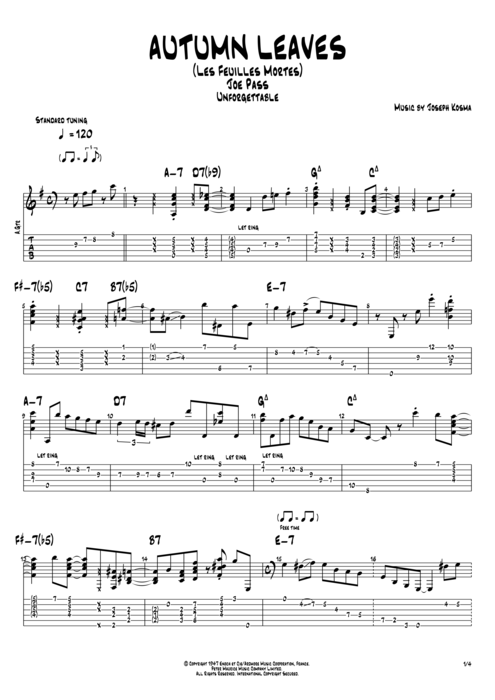Autumn Leaves Solo Guitar Pdf Torrent

Jazz guitar comping is an art form in its own right. The comping rhythms, melodies, and voicings of the greatest Jazz guitarists are delightful to listen to, with or without a soloist present. But how is it that some players manage to create such captivating comping ideas, while others fade into the background? A great accompanist can create motifs, melodies and rhythms that work with the ensemble without being overbearing, but that are still interesting on their own. The techniques and approaches for captivating Jazz guitar comping are scattered throughout recordings of the Jazz greats. Sometimes it only takes a few bars from a recording to learn truly unique comping techniques that you can use right away.
In this lesson, you’ll play through a Jim Hall comping example inspired by the Autumn Leaves recording from Ron Carter and Jim Hall on the Alone Together album. Using this comping example and the Jim Hall chords contained within, you’ll derive 5 different concepts that you can immediately apply to your own playing in countless ways. Free Jazz Guitar eBook: Pick up a free copy of my and learn more about comping, improvisation and the necessities of playing Jazz guitar. Below is the Jim Hall comping example itself.
Included with the music and tab notation are the recorded audio example and a backing track to help you practice. Each new musical exercise in this lesson will contain both audio and backing tracks to aid you in learning.
Start off by playing and getting familiar with this Jim Hall comping example, then you can move on to the techniques required to comp like this. Fifa 14 Ps2 Iso Direct Download there. Click to listen Backing Track After playing through the Jim Hall comping excerpt, it’s time to go deeper and find out what’s really going here.
Jump to Autumn Leaves. Help you learn how to comp the chords to Autumn Leaves on guitar. Notice the repeat sign for the first-eight bars, which is easy to miss on the sheet. Also, work this study with a metronome first, then bring it to the backing track when ready. Backing Track easy-autumn-leaves-backing-track. Autumn Leaves Eva Cassidy Tabbed by www.GoliathGuitarTutorials.com Please consider making a small donation to support this Project 1/3 for a Free HD tutorial.
Here’s a menu that will allow you to jump to the different topics contained in the lesson. Harmonic Analysis After playing through the Jim Hall comping example, the first step is to take a look at the individual chords and identify them. Breaking down the chords found in the excerpt will provide you with an opportunity to add them to your own playing and chordal vocabulary. Bar 1 – Cm9/C9 (iim7) Over the Cm7, two chords are featured.
The first chord is a fragment of a Cm9 chord and the second chord is a fragment of a C9 chord. What you’ll notice is that in both chords, the root is excluded.
In many comping examples that feature bass and guitar, the root is excluded from the chord. Jazz guitarists often exclude the root in favour of more colourful tones, especially due to the fact that the bass player will be covering the root note. As these chords exist in the lower register of the guitar, you’ll immediately generate a darker, more unique sound – this is especially true when extensions are present (such as the 9 th). Bar 2 – F9 (V7) In bar 2, a single F9 chord is broken up into two chords, providing a sense of harmonic movement. Having the ability to play two chords in one shape is also very easy on the hands!
Bar 3 – Bbmaj7, Bb9 (Imaj7) In bar 3, over the Bbmaj7 chord, 2 chords are featured. Both chords are triads and both chords exclude the root note of the Bbmaj7 chord. The first triad is a Dm chord, which contains the notes D, F and A.
The second triad is an F chord that contains notes F, A and C. Why F major and Dm triads?
Take a look at how each triad corresponds to the chord tones in a Bbmaj9 chord. Bbmaj9 Bb D F A C Dm Triad – R b3 5 – F Triad – – R 3 5 The Dm can be found starting on the chord 3rd of Bbmaj9, and the F major triad starts from the 5th of the Bbmaj9 chord. Bar 4 – Ebmaj7, Ebmaj13 (IVmaj7) In the last bar of the Jim Hall comping example, an Ebmaj7 chord is featured on the ‘ and’ of beat 1. Following the Ebmaj7 chord, a second type of Eb chord is played.
Comments are closed.